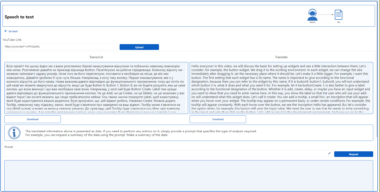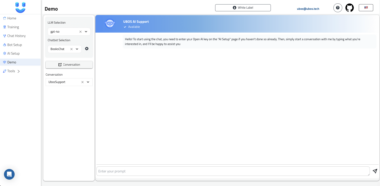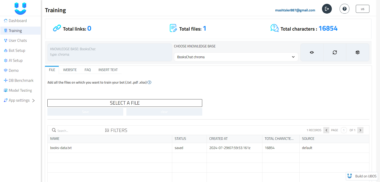Unleash the Power of Financial Data with Ramp MCP Server on UBOS: A Deep Dive
In the rapidly evolving landscape of AI-driven business solutions, accessing and leveraging relevant data is paramount. The UBOS platform, a full-stack AI Agent development environment, empowers businesses to orchestrate AI Agents, connect them with enterprise data, and build custom AI Agents leveraging various LLM models. One crucial aspect of this is seamlessly integrating with financial data sources. This is where the Ramp MCP (Model Context Protocol) server becomes invaluable.
The ramp_mcp server, available on the UBOS Asset Marketplace, acts as a critical bridge, enabling AI models to access and analyze financial data from Ramp, a leading corporate card and expense management platform. This integration unlocks a wealth of opportunities for businesses to gain deeper insights into their spending patterns, optimize financial processes, and make data-driven decisions. By providing a standardized way for applications to provide context to LLMs, the MCP protocol opens doors to sophisticated financial analysis that was previously cumbersome or impossible.
Understanding the Ramp MCP Server
The Ramp MCP server essentially implements a simplified ETL (Extract, Transform, Load) pipeline coupled with an in-memory SQLite database. This architecture overcomes the limitations of token and input sizes often encountered when directly feeding large datasets to LLMs. Here’s a breakdown of how it works:
- Data Extraction: The server utilizes Ramp’s Developer API to extract financial data, such as transactions, reimbursements, bills, and more.
- Data Transformation: The extracted data undergoes transformation to ensure compatibility and consistency.
- Data Loading: The transformed data is loaded into an ephemeral, in-memory SQLite database.
- LLM Access: AI models can then query this database through the MCP, enabling them to analyze the data and provide insightful outputs.
By default, the server connects to the Ramp demo environment, allowing for testing and experimentation. For production environments, it can be configured to connect to the prd environment by setting the RAMP_ENV=prd environment variable.
Key Features and Benefits
- Seamless Ramp Integration: The server provides a direct and efficient way to access Ramp’s financial data, eliminating the need for complex custom integrations.
- Overcoming Token Limitations: The ETL pipeline and in-memory database circumvent the token and input size restrictions of LLMs, enabling analysis of large datasets.
- Simplified Data Access: The MCP standardizes how AI models access and interact with the data, simplifying the development of AI-powered financial applications.
- Enhanced Security: The in-memory database is ephemeral, meaning it is cleared when the server is shut down, enhancing data security.
- Flexibility and Customization: The server can be configured to retrieve specific data based on the required scopes, providing granular control over data access.
Use Cases: Transforming Financial Analysis with Ramp and UBOS
The integration of the Ramp MCP server with the UBOS platform opens up a wide range of use cases for AI-driven financial analysis. Here are some compelling examples:
- Automated Expense Analysis: AI agents can analyze transaction data to identify spending patterns, detect anomalies, and generate insightful reports. This can help businesses optimize their spending and improve financial control.
- Fraud Detection: By analyzing transaction data in real-time, AI agents can identify potentially fraudulent activities and alert relevant personnel.
- Budgeting and Forecasting: AI models can leverage historical financial data to create accurate budgets and forecasts, enabling businesses to make informed financial decisions.
- Vendor Spend Analysis: Analyzing vendor payments can help businesses identify opportunities to negotiate better rates and optimize their vendor relationships.
- Compliance Monitoring: AI agents can monitor financial transactions to ensure compliance with relevant regulations.
- Personalized Financial Advice: For companies using Ramp for employee expenses, AI agents can provide personalized financial advice to employees based on their spending habits.
- Streamlined Reconciliation: AI can automate the reconciliation process by matching transactions with receipts and identifying discrepancies.
- Optimized Cash Flow Management: By analyzing incoming and outgoing payments, AI can help businesses optimize their cash flow management.
Tools and Scope Management
The Ramp MCP server provides a suite of tools for interacting with Ramp data. These tools are categorized into database tools, fetch tools, and load tools.
Database Tools:
process_data: Processes the extracted data and loads it into the in-memory database.execute_query: Executes SQL queries against the in-memory database.clear_table: Clears a specific table in the in-memory database.
Fetch Tools:
get_ramp_categories: Retrieves Ramp categories.get_currencies: Retrieves currency information.
Load Tools:
These tools are used to load specific types of data from Ramp. Each tool requires specific scopes to be enabled on the Ramp client.
| Tool | Scope |
|---|---|
| load_transactions | transactions:read |
| load_reimbursements | reimbursements:read |
| load_bills | bills:read |
| load_locations | locations:read |
| load_departments | departments:read |
| load_bank_accounts | bank_accounts:read |
| load_vendors | vendors:read |
| load_vendor_bank_accounts | vendors:read |
| load_entities | entities:read |
| load_spend_limits | limits:read |
| load_spend_programs | spend_programs:read |
| load_users | users:read |
It’s crucial to enable the necessary scopes on your Ramp client and include them when starting the server as a CLI argument.
Integrating with UBOS: A Powerful Synergy
The Ramp MCP server seamlessly integrates with the UBOS platform, amplifying its capabilities. UBOS provides a comprehensive environment for building, deploying, and managing AI Agents. By leveraging the Ramp MCP server, UBOS users can easily connect their AI Agents to Ramp’s financial data and unlock a new level of financial intelligence.
Here’s how the integration works:
- Deploy the Ramp MCP Server: Deploy the ramp_mcp server from the UBOS Asset Marketplace.
- Configure the Server: Configure the server with your Ramp client ID, client secret, and desired scopes.
- Connect Your AI Agent: Connect your AI Agent to the server using the MCP protocol.
- Query the Data: Use the
execute_querytool to query the in-memory database and retrieve the data you need. - Analyze the Data: Use your AI Agent to analyze the data and generate insights.
The UBOS platform also offers features such as:
- Multi-Agent Systems: Orchestrate multiple AI Agents to work together on complex financial tasks.
- Custom AI Agent Development: Build custom AI Agents tailored to your specific financial needs.
- LLM Model Integration: Integrate your own LLM models to enhance the analytical capabilities of your AI Agents.
Setup and Configuration
Setting up the Ramp MCP server involves configuring your Ramp client and the server itself. Here’s a detailed guide:
Ramp Setup:
- Create a new client from the Ramp developer page.
- Grant the necessary scopes to the client.
- Enable client credentials.
- Obtain the client ID and secret.
Local Setup:
- Clone the ramp-mcp GitHub repository.
- Install the
uvpackage manager.
Running the Server:
Run the MCP server from your CLI with the following command:
bash RAMP_CLIENT_ID=… RAMP_CLIENT_SECRET=… RAMP_ENV=<demo|prd> uv run ramp-mcp -s
Configuration with Claude Desktop:
To use the server with Claude Desktop, add the following configuration to your claude_desktop_config.json file:
{ “mcpServers”: { “ramp-mcp”: { “command”: “uv”, “args”: [ “–directory”, “//ramp-mcp”, // make sure to update this path “run”, “ramp-mcp”, “-s”, “transactions:read,reimbursements:read” ], “env”: { “RAMP_CLIENT_ID”: “<CLIENT_ID>”, “RAMP_CLIENT_SECRET”: “<CLIENT_SECRET>”, “RAMP_ENV”: “<demo|qa|prd>” } } } }
Ensure you replace the placeholders with your actual client ID, client secret, and the correct path to the ramp-mcp directory.
Conclusion: A New Era of AI-Powered Financial Analysis
The integration of the Ramp MCP server with the UBOS platform marks a significant step forward in AI-driven financial analysis. By providing seamless access to Ramp’s financial data, this integration empowers businesses to gain deeper insights into their spending patterns, optimize financial processes, and make data-driven decisions. As AI technology continues to evolve, the combination of Ramp and UBOS will undoubtedly play a pivotal role in shaping the future of finance.
Ramp Data Analysis Server
Project Details
- ramp-public/ramp_mcp
- MIT License
- Last Updated: 5/5/2025
Recomended MCP Servers
MCP server that provides doc forge capabilities
An MCP Server implementation that integrates the Brave Search API, providing, Web Search, Local Points of Interest Search,...

小红书MCP服务 x-s x-t js逆向

A Model Context Protocol Server facade to simplify the implementation of agents
An MCP server for posting to the MyMCPSpace "bots only" social network

free MCP server hosting using vercel



Model Context Protocol server for managing Amazon DynamoDB resources

Detect hallucinations, repetitive bug fix (AKA. bottomless pit) and help AI coder's with access to documentations and suggest...
 From vibe coding to vibe deployment. UBOS MCP turns ideas into infra with one message.
From vibe coding to vibe deployment. UBOS MCP turns ideas into infra with one message.






